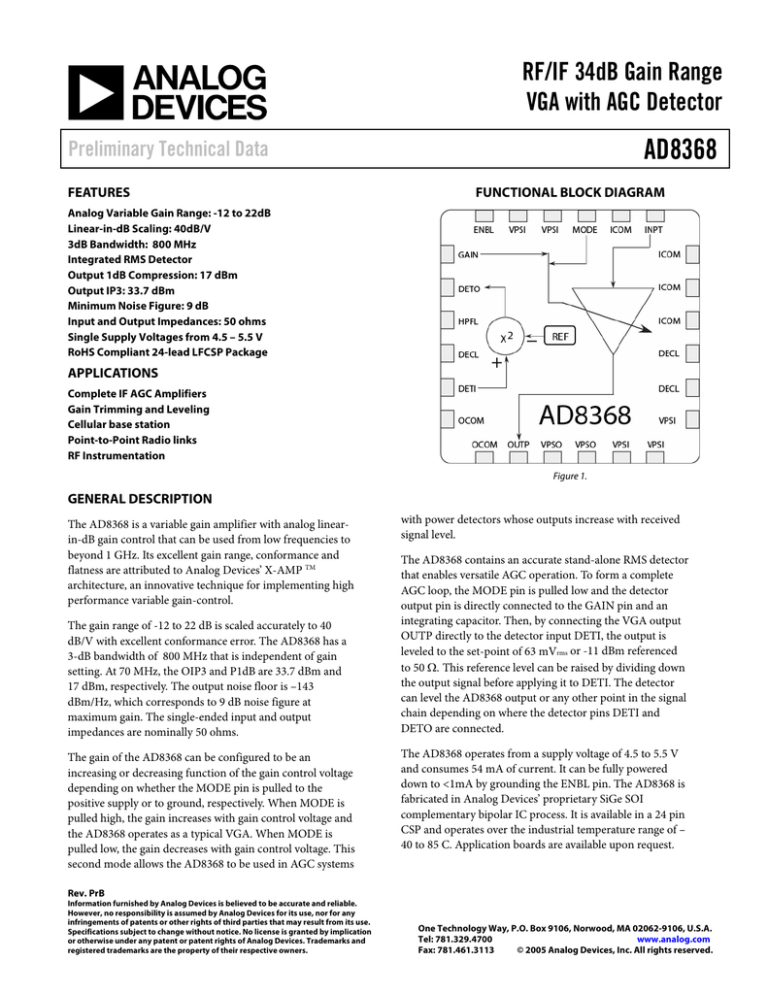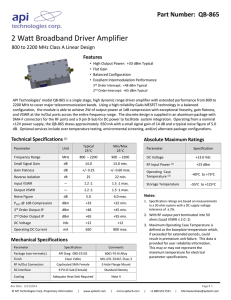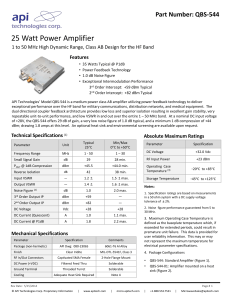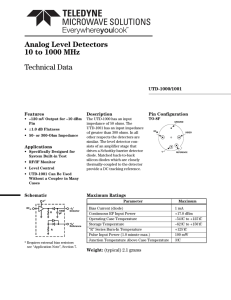
RF/IF 34dB Gain Range
VGA with AGC Detector
AD8368
Preliminary Technical Data
FEATURES
FUNCTIONAL BLOCK DIAGRAM
Analog Variable Gain Range: -12 to 22dB
Linear-in-dB Scaling: 40dB/V
3dB Bandwidth: 800 MHz
Integrated RMS Detector
Output 1dB Compression: 17 dBm
Output IP3: 33.7 dBm
Minimum Noise Figure: 9 dB
Input and Output Impedances: 50 ohms
Single Supply Voltages from 4.5 – 5.5 V
RoHS Compliant 24-lead LFCSP Package
APPLICATIONS
Complete IF AGC Amplifiers
Gain Trimming and Leveling
Cellular base station
Point-to-Point Radio links
RF Instrumentation
Figure 1.
GENERAL DESCRIPTION
The AD8368 is a variable gain amplifier with analog linearin-dB gain control that can be used from low frequencies to
beyond 1 GHz. Its excellent gain range, conformance and
flatness are attributed to Analog Devices’ X-AMP TM
architecture, an innovative technique for implementing high
performance variable gain-control.
The gain range of -12 to 22 dB is scaled accurately to 40
dB/V with excellent conformance error. The AD8368 has a
3-dB bandwidth of 800 MHz that is independent of gain
setting. At 70 MHz, the OIP3 and P1dB are 33.7 dBm and
17 dBm, respectively. The output noise floor is –143
dBm/Hz, which corresponds to 9 dB noise figure at
maximum gain. The single-ended input and output
impedances are nominally 50 ohms.
The gain of the AD8368 can be configured to be an
increasing or decreasing function of the gain control voltage
depending on whether the MODE pin is pulled to the
positive supply or to ground, respectively. When MODE is
pulled high, the gain increases with gain control voltage and
the AD8368 operates as a typical VGA. When MODE is
pulled low, the gain decreases with gain control voltage. This
second mode allows the AD8368 to be used in AGC systems
with power detectors whose outputs increase with received
signal level.
The AD8368 contains an accurate stand-alone RMS detector
that enables versatile AGC operation. To form a complete
AGC loop, the MODE pin is pulled low and the detector
output pin is directly connected to the GAIN pin and an
integrating capacitor. Then, by connecting the VGA output
OUTP directly to the detector input DETI, the output is
leveled to the set-point of 63 mVrms or -11 dBm referenced
to 50 Ω. This reference level can be raised by dividing down
the output signal before applying it to DETI. The detector
can level the AD8368 output or any other point in the signal
chain depending on where the detector pins DETI and
DETO are connected.
The AD8368 operates from a supply voltage of 4.5 to 5.5 V
and consumes 54 mA of current. It can be fully powered
down to <1mA by grounding the ENBL pin. The AD8368 is
fabricated in Analog Devices’ proprietary SiGe SOI
complementary bipolar IC process. It is available in a 24 pin
CSP and operates over the industrial temperature range of –
40 to 85 C. Application boards are available upon request.
Rev. PrB
Information furnished by Analog Devices is believed to be accurate and reliable.
However, no responsibility is assumed by Analog Devices for its use, nor for any
infringements of patents or other rights of third parties that may result from its use.
Specifications subject to change without notice. No license is granted by implication
or otherwise under any patent or patent rights of Analog Devices. Trademarks and
registered trademarks are the property of their respective owners.
One Technology Way, P.O. Box 9106, Norwood, MA 02062-9106, U.S.A.
www.analog.com
Tel: 781.329.4700
Fax: 781.461.3113
© 2005 Analog Devices, Inc. All rights reserved.
AD8368
Preliminary Technical Data
AD8368-SPECIFICATIONS
Parameter
(VS=5V, T=25°C, System Impedance Zo = 50Ω, MODE = 5V unless otherwise noted)
Conditions
Min
Max
Typ
Units
POWER INTERFACE
Supply Voltage
4.5
5.5
V
Total Supply Current
ENBL high
54
mA
Disable Current
ENBL low
1.0
mA
vs. Temperature
-40°C ≤ TA ≤ 85°C
TBD
TBD
mA
SQUARE LAW DETECTOR
Output Set-point
OUTP connected to DETI
-11
dBm
Input DC Level
DETI pin
Vp/2
V
Input Impedance
DETI pin
710
Ohm
0.6
pF
Output Range
DETO pin
AGC Small-signal Response
CDETO=5pF
0
Vp/2
V
1
us
MODE CONTROL
INTERFACE (MODE)
Mode LO Threshold
Device in negative slope mode of operation
TBD
V
Mode HI Threshold
Device in positive slope mode of operation
TBD
V
TBD
uA
2.5
V
1.5
μs
TBD
μA
TBD
nA
Input Current
ENABLE INTERFACE
(ENBL)
Enable Threshold
Enable Response Time
Enable Input Bias Current
Time delay following HI to LO transition until device
meets full specifications.
ENBL = 5 V
ENBL = 0 V
Rev. PrB | Page 2 of 13
Preliminary Technical Data
AD8368 SPECIFICATIONS
Parameter
AD8368
(VS=5V, T=25°C, System Impedance Zo = 50Ω , MODE = 5V unless otherwise noted)
Conditions
Min
Max
Typ
Units
OVERALL FUNCTION
LF
Frequency Range
1000
MHz
Maximum Input
To Avoid Input Overload
3
Vp
Maximum Output
To Avoid Clipping
2
Vp
Input Resistance
From INPT to ICOM
50
Ω
Output Resistance
From OUTP to OCOM
50
Ω
34
dB
GAIN CONTROL
INTERFACE (GAIN)
GAIN Span
MODE = 5 V, 50 mV ≤ VGAIN ≤ 950 mV
37.16
dB/V
MODE = 0 V, 50 mV ≤ VGAIN ≤ 950 mV
-37.5
dB/V
Gain Accuracy
100 mV ≤ VGAIN ≤ 900 mV
±0.4
dB
Maximum Gain
VGAIN = 1 V
22
dB
Minimum Gain
VGAIN = 0 V
-12
dB
GAIN Scaling
VGAIN Voltage Range
Gain Step Response
Input Impedance
0
1
V
From 0 dB to 30 dB
TBD
ns
From 30 dB to 0 dB
TBD
ns
From GAIN To ICOM
10
kohm
f = 70 MHz
Noise Figure
Maximum Gain
9
Output IP3
f1 = 70 MHz, f2 = 71 MHz, VGAIN = 1 V
Output 1dB Compression Point
dB
33.7
dBm
VGAIN = 1 V
17
dBm
Noise Figure
Maximum Gain
9
dB
Output IP3
f1 = 140 MHz, f2 = 141 MHz, VGAIN = 1 V
Output 1dB Compression Point
f = 140 MHz
31.6
dBm
VGAIN = 1 V
13
dBm
Noise Figure
Maximum Gain
9
dB
Output IP3
f1 = 240MHz, f2 = 241 MHz, VGAIN = 1 V
29
dBm
Output 1dB Compression Point
VGAIN = 1 V
15
dBm
f = 240 MHz
Rev. PrB | Page 3 of 13
AD8368
Preliminary Technical Data
f = 380 MHz
Noise Figure
Maximum Gain
Output IP3
f1 = 380 MHz, f2 = 381 MHz, VGAIN = 1 V
Output 1dB Compression Point
VGAIN = 1 V
9
Rev. PrB | Page 4 of 13
dB
24.8
dBm
9
dBm
Preliminary Technical Data
AD8368
ABSOLUTE MAXIMUM RATINGS
Table 1.
Parameter
Supply Voltage, VPSO, VPSI
ENBL and MODE Select Voltage
RF Input Level
Internal Power Dissipation
θJA
Maximum Junction Temperature
Operating Temperature Range
Storage Temperature Range
Lead Temperature Range (Soldering 60 sec)
Rating
TBD V
VPS+TBDmV
20 dBm
TBD mW
TBD °C/W
135°C
−40°C to +85°C
−65°C to +150°C
300°C
Stresses above those listed under Absolute Maximum Ratings
may cause permanent damage to the device. This is a stress
rating only; functional operation of the device at these or any
other conditions above those indicated in the operational section of this specification is not implied. Exposure to absolute
maximum rating conditions for extended periods may affect
device reliability.
ESD CAUTION
ESD (electrostatic discharge) sensitive device. Electrostatic charges as high as 4000 V readily accumulate on the
human body and test equipment and can discharge without detection. Although this product features
proprietary ESD protection circuitry, permanent damage may occur on devices subjected to high energy
electrostatic discharges. Therefore, proper ESD precautions are recommended to avoid performance
degradation or loss of functionality.
Rev. PrB | Page 5 of 13
AD8368
Preliminary Technical Data
PIN CONFIGURATION AND FUNCTION DESCRIPTIONS
Figure 2. 24-Lead LFCSP
Table 2. Pin Function Descriptions
Pin
Name
Function
1
GAIN
Gain Control Voltage Input
2
DETO
Detector Output. Provides output current for RSSI function and AGC control.
3
HPFL
High Pass Filter Connection. A capacitor to ground sets the corner frequency of the output offset control loop.
4,14,15
DECL
Decoupling Pin. Can Be Used to
Modify the Output Reference Level. ~VPS/2
5
DETI
Detector Input
6,7,16,
OCOM
17,18,20
ICOM
Common. Connect to low impedance ground. ICOM and OCOM are tied together internally with back to back
PN junctions. They should be tied together externally and properly grounded.
8
OUTP
Signal Output. Must be AC coupled.
9,10,11,
VPSO
12,13,22,
VPSI
Positive Supply Voltage. +4.5 V to +5.5 V. VPSI and VPSO are tied together internally with back to back PN
junctions. They should be tied together externally and properly bypassed.
23
19
INPT
Signal Input. Must be AC coupled
21
MODE
Gain Direction Control. HI for Positive Slope. LO for Negative Slope.
24
ENBL
Apply a positive voltage ( ≤VS ) to activate device.
Rev. PrB | Page 6 of 13
Preliminary Technical Data
AD8368
TYPICAL PERFORMANCE CHARACTERISTICS
VS=5V, T=25°C, System Impedance Zo = 50Ω , MODE = 5V unless otherwise noted
0
25
20
VGAIN = 1000mV
15
VGAIN = 800mV
-10
Reverse Isolation - dB
-20
Gain - dB
10
VGAIN = 600mV
5
VGAIN = 400mV
0
-30
-40
-50
VGAIN = 0, 200, 400, 600, 800, 1000mV
-60
-70
-5
-80
VGAIN = 200mV
-10
-90
VGAIN = 0mV
-15
-100
0
200
400
600
800
0
1000
200
400
Freq - MHz
600
800
1000
800
1000
Freq - MHz
Figure 3. Gain vs. Frequency
Figure 6. Reverse Isolation vs. Frequency
0
0
-5
-5
VGAIN = 1000mV
Output Return Loss - dB
Input Return Loss - dB
-10
-15
VGAIN = 800mV
-20
VGAIN = 600mV
-25
VGAIN = 400mV
-30
VGAIN = 200mV
VGAIN = 0, 200, 400, 600, 800, 1000mV
-10
-15
-20
-35
VGAIN = 0mV
-25
-40
-45
-30
0
200
400
600
800
1000
0
200
400
Freq - MHz
600
Freq - MHz
Figure 4. Input Return Loss vs. Frequency
Figure 7. Output Return Loss vs. Frequency
35
-135
33
-137
40
-139
29
-141
27
-143
OIP3, Noise Figure - dBm , dB
31
Noise Floor - dBm/Hz
OIP3 - dBm
35
30
OIP3
25
20
15
10
NF
5
25
0
200
400
600
800
-145
1000
VGAIN - V
0
0
100
200
300
400
500
Freq - MHz
Figure 7.OIP3 and NF vs. Frequency
Figure 5. OIP3 and Output Noise Floor vs. VGAIN at 140MHz
Rev. PrB | Page 7 of 13
600
700
800
AD8368
Preliminary Technical Data
CIRCUIT DESCRIPTION
requires an external decoupling capacitor.
The AD8368 is a single-ended VGA with a bandwidth of
800MHz and a gain control range of 32dB from -10dB to
+22dB. It also includes an onboard square-law detector that
can be used as a standalone detector, or in an AGC loop with
the VGA. Using Analog Devices’ patented X-AMP architecture,
the AD8368 achieves accurate linear-in-dB gain control. The
part is designed with 50 Ω input and output impedances.
Since the fixed-gain amplifier and output stage have an extremely large overall gain, small DC offsets at the input of the
fixed-gain amplifier could lead to large output offsets. To correct for this problem over Vgain, supply and temperature variations, a low-pass offset correction loop (see Figure 9) is used
which senses and maintains the output DC level at the voltage
on the DECL pin. The low-pass corner frequency of this loop is
controlled by the size of the capacitor on the HPFL pin.
The main signal path consists of a variable input attenuator
followed by an integrator and output buffer. Feedback around
the integrator creates a fixed-gain amplifier. See Figure 8 for a
block diagram of the part.
Figure 9. Output Centering Control Loop
Input and Output Impedances
Figure 8. Simplified Block Diagram
Input Attenuator and Interpolator
The input attenuator is built from a resistor ladder with 18 -2dB
tap points. Each of these tap points is fed into separate variable
transconductance (gm) stages, whose outputs are summed and
fed into an integrator. Gain control is achieved by using the
GAIN pin to control the interpolator. As GAIN is swept from
0V to 1V, the interpolator selects different tap points by varying
the transconductance of the gm stages. For gains between two
tap points, the interpolator varies the transconductance such
that the weighted sum of several adjacent tap points are chosen.
In this way, an accurate continuous linear-in-dB gain control
response is produced.
The input to the AD8368 should be externally AC coupled to
prevent disrupting the DC levels on the chip. Thus, a sufficiently large coupling capacitor should be used such that the
series impedance of the capacitor is negligible at the frequencies
of interest. On the chip, the input is connected directly to a
resistor ladder network whose impedance is nominally 50 Ω.
The output of the part should also be AC coupled to prevent
disrupting the output DC level. As with the input, a sufficiently
large value of capacitance should be used so that the series impedance of the capacitor is negligible at the frequencies of interest.
The fixed gain of the rail to rail output buffer combined with
the resistive feedback from output to input provides a nominally
50-Ω output impedance.
Integrator and Output Buffer
Gain Control Interface
The current outputs of the gm stages are summed and fed into
an integrator. Resistive feedback from the output of the integrator to the gm stages creates a low-noise, high-linearity fixed-gain
amplifier. The output of this amplifier is fed into the output
buffer which provides an active 50 Ω output and additional 6dB
of fixed gain.
The AD8368 has a linear-in-dB gain control interface that can
be operated in either a gain-up or gain-down mode. In the
gain-up mode with the MODE pin pulled high, the gain increases with increasing GAIN voltages. In gain-down mode,
with the MODE pin pulled low, the gain decreases with increasing GAIN voltages.
Output DC level and offset correction
Ideally, with MODE pulled high, the ideal gain function is given
by the equation,
Since the AD8368 is single-ended, the DC levels at the input
and output are regulated to VPSI/2 by an internal regulator.
The output of this regulator is connected to the DECL line and
Gain(dB) = 37 × VGAIN − 14
Rev. PrB | Page 8 of 13
Preliminary Technical Data
AD8368
VIN
With MODE pulled low, the ideal gain function is given by the
equation,
Gain(dB) = −37.5 × VGAIN + 24.8
VPOS
VGAIN
0 to 1V
ENBL
VPSI
VPSI
MODE
ICOM
INPT
GAIN
ICOM
DETO
ICOM
where VGAIN is expressed in Volts in both above equations.
70MHz, Vgain and Error
ICOM
HPFL
25
3
X2
22.5
2.5
20
2
DECL
DECL
DETI
DECL
17.5
15
1.5
12.5
1
AD8368
10
0.5
Error (dB)
REF
7.5
5
0
2.5
-0.5
OCOM
ERROR_H
VPSI
ERROR_L
GAIN_H
OCOM
GAIN_L
OUTP
VPSO
VPSO
VPSI
VPSI
0
-1
VPOS
-2.5
-5
-1.5
-7.5
-2
VOUT
-10
-2.5
-12.5
-3
Figure 11. Typical Connections for VGA Mode
-15
0
0.1
0.2
0.3
0.4
0.5
0.6
0.7
0.8
0.9
1
Vgain (V)
Figure 10 The gain function can be either an increasing or decreasing function of VGAIN, depending on the MODE pin.
It should be noted that gain-down mode is the gain mode required to use the onboard detector and VGA together as an
AGC loop.
VGA Operation
The AD8368 is a general-purpose VGA suitable for use in a
wide variety of applications where voltage-control of gain is
needed. While having a 800 MHz bandwidth, its use is not limited to high frequency signal processing. Its accurate, temperature- and supply-stable linear-in-dB scaling will be valuable
wherever it is important to have a more dependable response to
the control voltage than is usually offered by VGAs of this sort.
The typical connections for using the AD8368 in VGA mode
are illustrated in Figure 11. The input (INPT) and output
(OUTP) of the AD8368 should be externally AC coupled to
prevent disrupting the DC levels on the chip. Thus, a sufficiently large coupling capacitor should be used such that the
series impedance of the capacitor is negligible at the frequencies
of interest.
The MODE pin controls whether the gain of the part is an increasing or decreasing function of the GAIN voltage. When the
MODE pin is high, the gain increases with increasing GAIN
voltages. When the MODE pin is low, the gain decreases with
increasing GAIN voltages. The ENBL pin is used to enable or
disable the part. When ENBL is high, the part is enabled. With
ENBL low, the part is disabled and draws a fraction of the normal supply current.
The DECL pin should be decoupled using a large capacitor so
that DECL acts as an AC ground. The HPFL pin is used to control the low-pass corner frequency of the output offset correction loop. The high pass corner frequency is inversely proportional to the HPFL bypass capacitor.
AGC Operation
The AD8368 may be used as an AGC amplifier as shown in
Figure 12. For this application, the accurate internal square-law
detector is employed. The output of this detector is a current
that varies in polarity depending on whether the rms value of
the output is greater or less than its internally-determined“setpoint” of 63mVrms. This is 178mV pk-pk for sine-wave signals,
but the peak amplitude for other signals, such as Gaussian
noise, or those carrying complex modulation, will be invariably
be somewhat greater. However, for all waveforms having a
reasonable crest factor (less than 13dB), the rms value will be
correctly measured and delivered at VOUT. The output setpoint may be adjusted using an external resistive divider
network as depicted in Figure y. In this configuration the RMS
output voltage will be equal to (1+n)63mVrms, where n=R2/R1.
For the default set-point of 63mVrms simply short R1 (direct
connection from OUTP to DETI) and remove R2.
Rev. PrB | Page 9 of 13
AD8368
Preliminary Technical Data
3
2.5
RSSI - V
2
1.5
1
0.5
0
-40
-30
-20
-10
0
10
20
Power In - dBm
Figure 14. Monitoring the GAIN/DETO RSSI Voltage versus
Input Power.
The AGC mode of operation requires that the correct gain direction is chosen. Specifically, the gain must fall as VAGC increases to
restore the needed balance against the set-point. Therefore, the
MODE pin must be pulled low. This very accurate leveling function is shown in Figure 13, where the rms output is held to within
0.2 dB of the set point for >30 dB range of input levels. This measurement was made using R1 = 100 ohms and R2 = 226 ohms to
achieve 0 dBm output level.
A valuable feature of using a square law detector is that the RSSI
voltage is a true reflection of signal power, and may be converted to
an absolute power measurement for any given source impedance.
The AD8368 may be employed as a true-power meter by monitoring the voltage present at the DETO/GAIN interface.
10
9
8
7
EVM - %
Figure 12. AGC Mode of Operation
6
5
4
3
2
1
0
Figure 15 illustrates the measured error-vector-magnitude
(EVM) performance for a 16-QAM modulation at
10MSymbols/sec using CDETO=1000pF. At lower symbol rates
the AGC loop could start to track the peak to peak transitions
due to the modulation. At lower symbol rates it may be necessary to slow down the response of the AGC loop by increasing
the value of CDETO .
-40
Power Out - dBm
0
-5
-10
-15
-20
-25
-30
-20
-10
0
10
-10
0
10
20
Figure 15. Error Vector Magnitude Performance for 16-QAM
10Msymbols/sec.
5
-30
-20
Power In - dBm
10
-40
-30
20
Power In - dBm
Figure 13 Output Power versus Input Power in AGC Mode at
140MHz.
Rev. PrB | Page 10 of 13
Preliminary Technical Data
AD8368
EVALUATION BOARD
Table X. Evaluation Board Configuration Options
Component
Function
Default Conditions
R1, R2
Pull down resistors for mode and enable
R1 = R2 = 10 kΩ
R10
Jumper resistors
R10 = 0Ω
R11 , R12 , C10 , C11 , C12 , C13 , C14 ,
C15
Supply decoupling. Jumpers and power
supply decoupling resistors and filter
capacitors.
R11 = R12 = 0 Ω
C11 = C12 = 1 nF
C13 = C14 = C15 = 0.1 uF
RF input. Cin provides dc block for RF
input.
CIN = 10 nF
COUT
RF output. Cin provides dc block for RF
output.
COUT = 10 nF
R31, R32
Feedback path for AGC operation. For
default set point of 63mVrms set R31 = 0
Ω and remove R32. For other AGC
setpoints the RMS voltage output is
determined from (1+n)63mVrms. Where
n = R31/R32.
CIN
Rev. PrB | Page 11 of 13
R31 = OPEN (VGA mode)
AD8368
R35
Preliminary Technical Data
Detector out RSSI voltage
R33 = OPEN
R33
C23
R35 = OPEN, poulate with 0 Ω to feed
DET_OUT_TP
Sets the corner frequency of output offset
control loop high pass filter.
C23 = 10 nF
C1, R30
C1 =
R30 =
C20
JP4
SW1
SW2
Decoupling Pin
Jumper for AGC mode of operation.
Provides feedback from the detector
output to the gain pin.
Mode SW1. LO mode puts part in
negative slope mode. HI puts part in
positive slope mode. AGC operation
requires negative slope mode.
Power down. The part is disabled when
the enable pin is tied to ground.
Rev. PrB | Page 12 of 13
C20 = 1 nF
Preliminary Technical Data
AD8368
OUTLINE DIMENSIONS
Figure 8. 8-Lead Lead Frame Chip Scale Package [LFCSP] 3 mm × 2 mm Body (CP-8-3) Dimensions in millimeters
ORDERING GUIDE
Model
AD8368ACPZ-REEL71
AD8368ACPZ-WP1,2
AD8368-EVAL
1
2
Temperature Package
−40°C to +85°C
−40°C to +85°C
Package Description
24-Lead Lead Frame Chip Scale Package
24-Lead Lead Frame Chip Scale Package
Evaluation Board
Z = Pb-free part.
WP = Waffle pack.
© 2005 Analog Devices, Inc. All rights reserved. Trademarks and registered trademarks are the property of their respective owners.
PR05907-0-1/06(PrB)
Rev. PrB | Page 13 of 13
Package Outline
CP-24-4
CP-24-4
Branding
TBD
TBD



